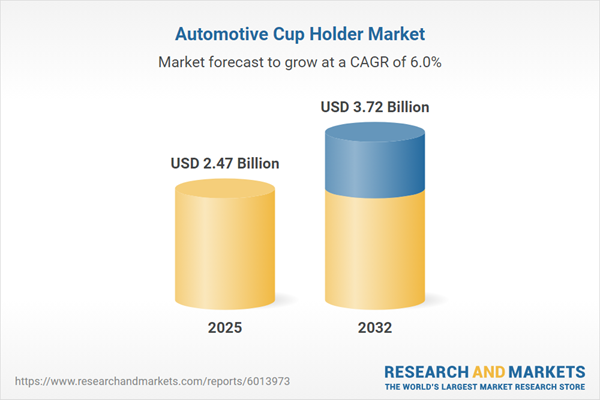Speak directly to the analyst to clarify any post sales queries you may have.
The automotive cup holder market is transforming vehicle interiors, responding to evolving user expectations for connectivity, convenience, and quality materials. As a critical component in modern automotive design, cup holders influence both consumer satisfaction and brand differentiation strategies.
Market Snapshot: Automotive Cup Holder Market Growth and Outlook
The automotive cup holder market grew from USD 2.33 billion in 2024 to USD 2.47 billion in 2025. It is projected to expand at a CAGR of 6%, reaching USD 3.72 billion by 2032. This growth reflects rising consumer demand for enhanced cabin experiences and the ongoing evolution of vehicle comfort features. The market’s trajectory is shaped by a steady integration of multifunctional modules, personalization options, and advanced materials across global automotive manufacturing segments.
Scope & Segmentation: A Comprehensive Look at Automotive Cup Holder Market Dimensions
This report dissects the market through all crucial lenses, including distribution channel, product type, materials, mounting positions, capacities, vehicle categories, and key geographies.
- Distribution Channels: OEM integration, Aftermarket retrofits
- Cup Holder Types: Fixed, Foldable, Retractable
- Cup Holder Materials: Composite (Carbon Fiber, Fiber Glass), Plastic (ABS, Polypropylene), Stainless Steel (304, 316)
- Mounting Positions: Center Console, Dashboard, Door Panel, Rear Seat
- Cup Holder Capacities: Single, Double, Triple
- Vehicle Types: Heavy Commercial Vehicle, Light Commercial Vehicle, Hatchback, Compact Sedan, Mid-Size Sedan, Compact SUV, Luxury SUV
- Regions Covered: Americas (North America, Latin America), Europe, Middle East & Africa, Asia-Pacific
- Key Companies Tracked: Yanfeng Automotive Interiors, Faurecia SE, Adient plc, Magna International Inc., Toyota Boshoku Corporation, Lear Corporation, Hyundai Mobis, Grupo Antolin S.A., Brose Fahrzeugteile GmbH & Co. KG, SHIROKI Corporation
Key Takeaways for Decision-Makers
- Advanced materials technologies are reshaping both the durability and aesthetics of cup holders, enabling OEMs to support lightweight and premium interior objectives.
- Ergonomic design, temperature control, and integrated smart features are increasingly influential in consumer vehicle purchase decisions, driving up technical collaboration between automakers and suppliers.
- There is a growing market divide between original equipment installations, which prioritize seamless aesthetic integration, and aftermarket solutions tailored to universal fit and user customization.
- The emergence of refined plastics and composite blends is supporting sustainability initiatives while enhancing longevity and tactile quality.
- Regional variations in climate, sustainability standards, and end-user behavior are prompting the tailoring of cup holder solutions for specific markets, especially in North America, Europe, and Asia-Pacific.
Tariff Impact: Navigating Regulatory and Cost Pressures
Recent United States tariff measures on imported steel and composites have compelled manufacturers to diversify material sourcing and explore regional supply alternatives. The adoption of domestic stainless steel and locally produced carbon fiber is accelerating, influencing production strategies and supplier relationships industry-wide. Strategic collaborations and capital investment adjustments are increasingly necessary to navigate shifting cost structures and maintain supply continuity across borders.
Methodology & Data Sources
Research for this report is based on a hybrid approach combining secondary analysis of industry publications, technical literature, and company disclosures with extensive primary research. Interviews and surveys with OEMs, aftermarket specialists, material producers, and regulatory agencies ensured that both quantitative trends and qualitative strategies were robustly captured for actionable insight.
Why This Report Matters: Strategic Value for Senior Leaders
- Enables focused investment and product development decisions through detailed market breakdowns by distribution channel, material, and region.
- Equips supply chain strategists with key insights into how tariff regulations and sourcing trends are shaping competitive advantage.
- Empowers innovation and differentiation leaders to align with emerging consumer preferences, technology integrations, and sustainability standards.
Conclusion
The future of automotive cup holders will be shaped by material innovation, regional differentiation, and advances in functionality. Strategic focus on adaptability, collaboration, and user-driven design is essential for market leadership as consumer expectations continue to evolve.
Additional Product Information:
- Purchase of this report includes 1 year online access with quarterly updates.
- This report can be updated on request. Please contact our Customer Experience team using the Ask a Question widget on our website.
Table of Contents
3. Executive Summary
4. Market Overview
7. Cumulative Impact of Artificial Intelligence 2025
Companies Mentioned
The companies profiled in this Automotive Cup Holder market report include:- Yanfeng Automotive Interiors Co., Ltd.
- Faurecia SE
- Adient plc
- Magna International Inc.
- Toyota Boshoku Corporation
- Lear Corporation
- Hyundai Mobis Co., Ltd.
- Grupo Antolin S.A.
- Brose Fahrzeugteile GmbH & Co. KG
- SHIROKI Corporation
Table Information
| Report Attribute | Details |
|---|---|
| No. of Pages | 186 |
| Published | October 2025 |
| Forecast Period | 2025 - 2032 |
| Estimated Market Value ( USD | $ 2.47 Billion |
| Forecasted Market Value ( USD | $ 3.72 Billion |
| Compound Annual Growth Rate | 6.0% |
| Regions Covered | Global |
| No. of Companies Mentioned | 11 |









